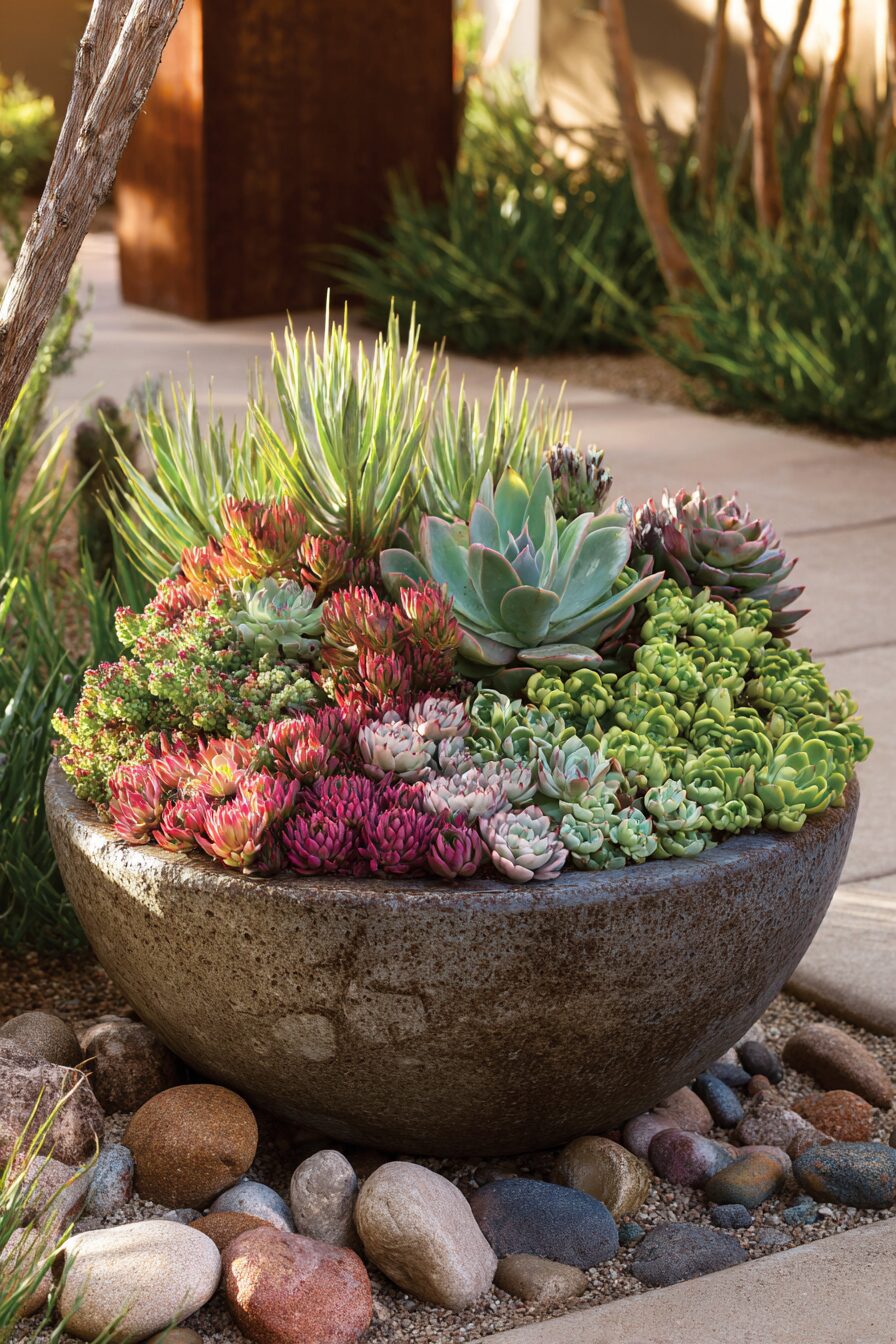Finding the perfect plants for those scorching sunny spots can be a challenge, but with the right choices, your sun-drenched patio or balcony can become a stunning oasis.
Full-sun containers need special attention, but they reward you with explosive growth and vibrant colors that shade gardens simply can’t match.
Here are container ideas are specifically designed for spots that receive 6+ hours of direct sunlight daily, combining beauty with practicality.
Mediterranean Garden

Imagine walking onto your patio and instantly being transported to the sun-drenched hills of Tuscany with just one deep breath.
A Mediterranean herb container garden doesn’t just look beautiful—it transforms your cooking while requiring minimal effort.
Herbs like rosemary, thyme, oregano, and sage don’t just tolerate full sun, they demand it to develop their intense aromatic oils.
These sun-worshippers evolved in rocky, poor soil conditions, making them incredibly forgiving even when you forget to water for a few days.
For the perfect Mediterranean container, choose a terracotta pot at least 12 inches deep to accommodate root growth and provide excellent drainage.
Fill it with a fast-draining potting mix with added perlite or coarse sand to mimic their native growing conditions.
Arrange your herbs with rosemary (a natural climber) at the back, bushy sage in the middle, and creeping thyme spilling over the edges for a gorgeous cascading effect.
The silver-blue and gray-green foliage creates a sophisticated color palette that looks stunning even when you’re not harvesting.
Water only when the top two inches of soil feel dry to the touch—these plants prefer being slightly underwatered than overwatered.
For a twist on the classic herb container, add a dwarf olive tree or lavender as a dramatic centerpiece surrounded by lower-growing herbs.
Fertilize sparingly—just once a month with half-strength balanced fertilizer as excessive nutrients actually reduce the concentration of flavorful essential oils.
Your Mediterranean container will thrive for years with minimal maintenance, often looking better with slight neglect as the plants become more gnarled and character-filled.
Desert Drama Succulent Display
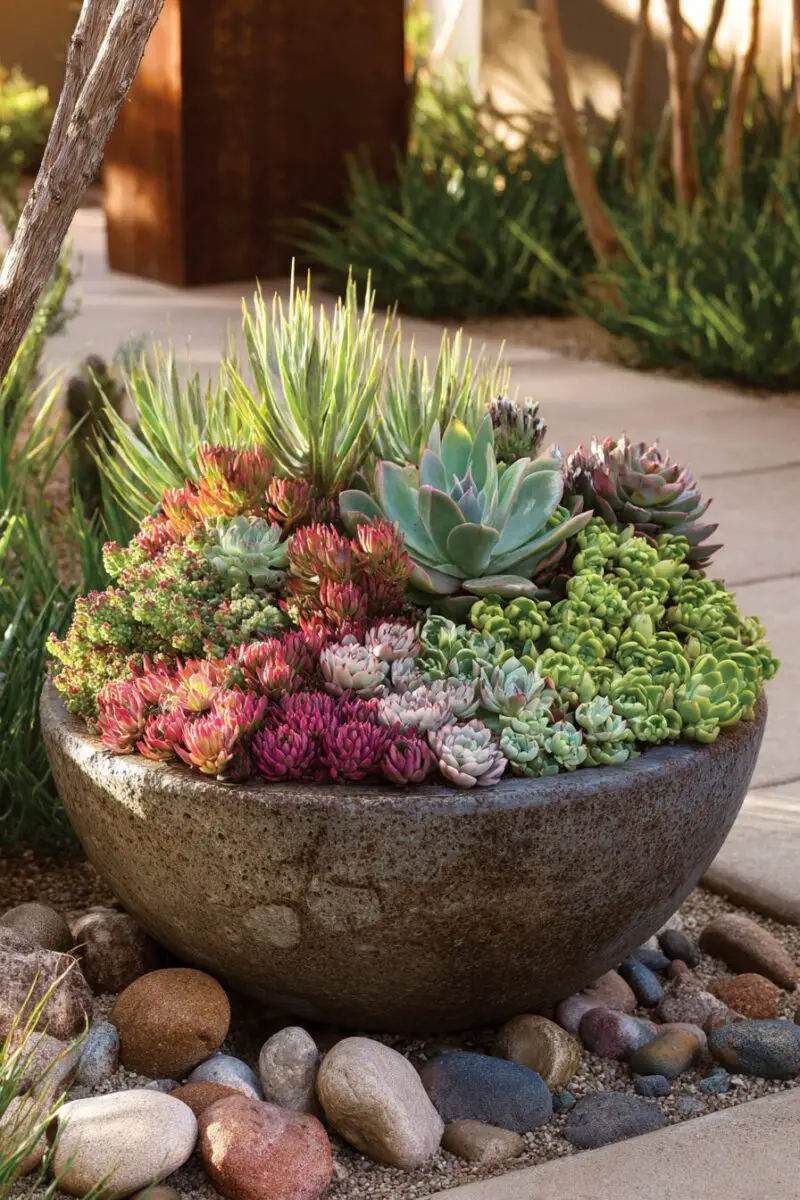
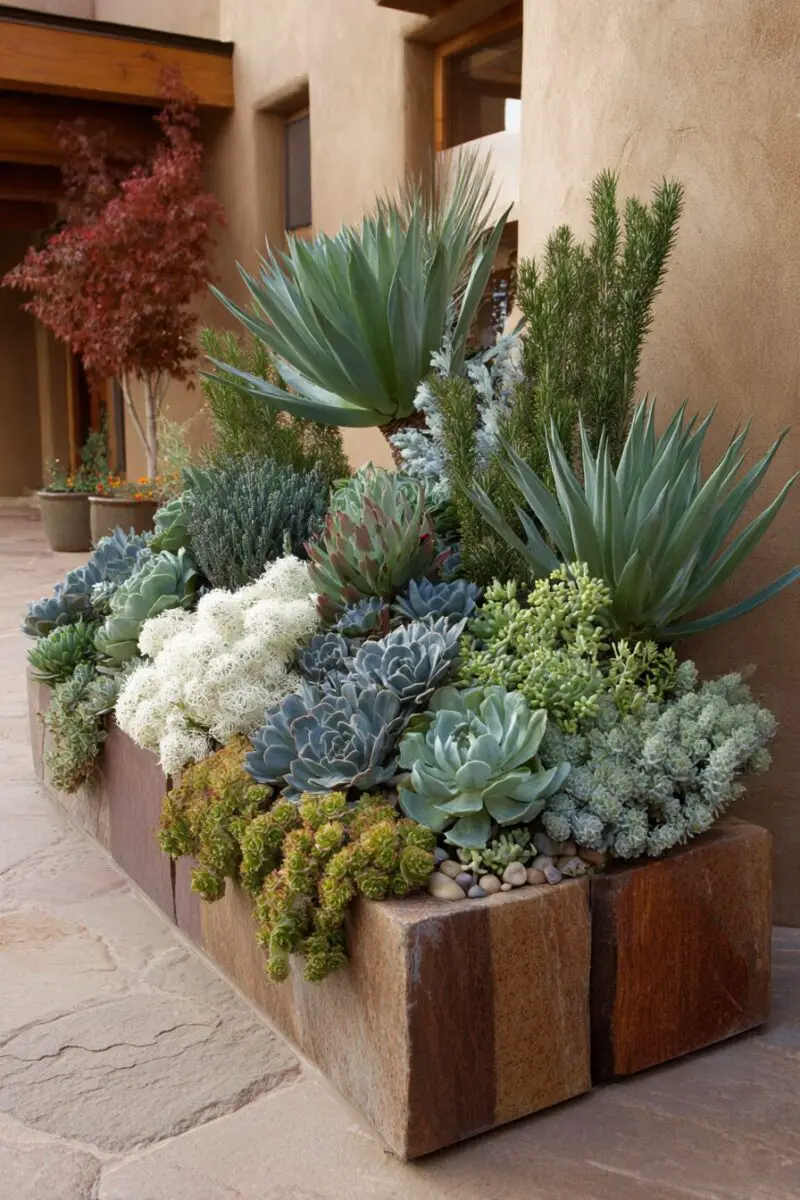
Nothing turns heads faster than a container that looks like it belongs in a high-end design magazine—and a well-crafted succulent arrangement delivers exactly that wow factor.
Succulents store water in their fleshy leaves and stems, making them the ultimate survivors for containers that bake in relentless sunshine.
Their architectural shapes and otherworldly colors create living sculptures that transform from interesting to absolutely spectacular as they mature.
For maximum impact, combine different heights, textures, and colors—pair spiky agave with rounded echeveria, and contrast blue-gray tones with bright lime green sedum.
Choose a wide, shallow container made of concrete, hypertufa, or glazed ceramic that complements the modern aesthetic of these plants while providing stability for top-heavy specimens.
Drainage is absolutely critical—drill extra holes if necessary, as succulents will rot quickly if their roots sit in water.
Use a specialized cactus/succulent potting mix or create your own by mixing regular potting soil with equal parts coarse sand and perlite or pumice.
Place your tallest, most dramatic specimen (like a paddle plant or large echeveria) slightly off-center as your focal point, not directly in the middle.
Add medium-sized plants around it, then tuck smaller varieties between them, and finally allow trailing types like string of pearls to cascade over the edges.
Top-dress with decorative gravel, crushed glass, or small river stones in a complementary color to complete the professional look and prevent soil splashing onto the leaves.
Water thoroughly but infrequently—once every 2-3 weeks in summer and even less in cooler months—waiting until the soil is completely dry.
Your succulent container will become more impressive over time, with many varieties producing offsets that can be removed and planted in new containers to expand your collection.
Design Your Dream Room in Minutes!
🏡 Start Creating FREE →Pizza Garden Container
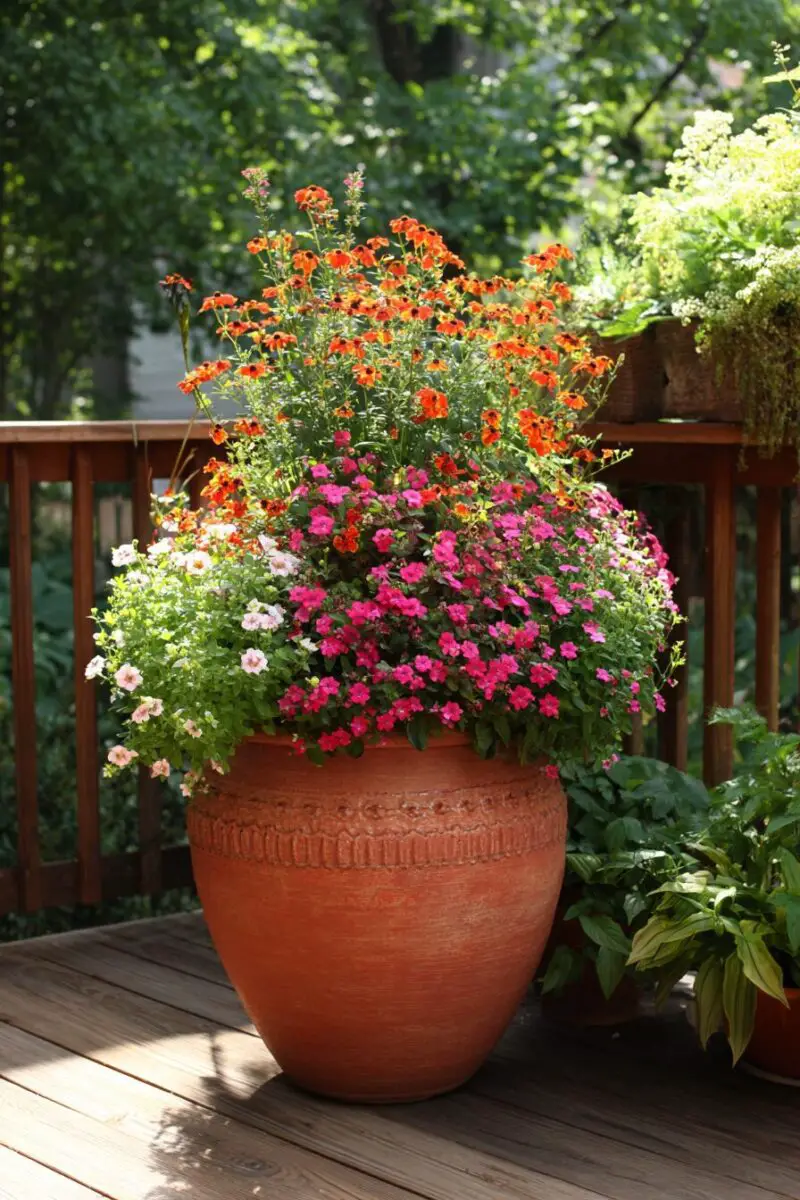

Imagine growing everything you need for homemade pizza toppings in one sun-drenched container just steps from your kitchen door.
A pizza garden container combines the satisfaction of growing your own food with the practicality of having fresh ingredients whenever inspiration strikes.
The intense flavor of container-grown tomatoes, basil, and peppers—all sun-loving plants—will elevate your homemade pizzas from ordinary to extraordinary.
Start with a large container at least 18-24 inches deep to accommodate the extensive root systems of tomatoes, the star of your pizza garden.
Choose a determinate (bush) tomato variety like ‘Patio Princess’ or ‘Tiny Tim’ that won’t outgrow your container, paired with compact sweet pepper varieties like ‘Lunchbox’ or ‘Mini Belle.’
Plant aromatic basil around the edges where you can easily harvest it without disturbing the larger plants, and it will naturally repel many tomato pests.
Include oregano as a trailing plant to spill over the sides—it’s not only decorative but provides the classic pizza herb flavor that dried versions can’t match.
Use high-quality potting soil enriched with compost, as these heavy feeders need plenty of nutrients to produce their flavorful fruits and leaves.
Water consistently, keeping the soil evenly moist but not waterlogged, as fluctuations in water can cause tomatoes to crack or develop blossom end rot.
Fertilize every two weeks with a balanced organic fertilizer, switching to one higher in phosphorus and potassium once flowering begins to encourage fruit production.
Position your pizza garden in your sunniest spot—these Mediterranean natives need at least 6-8 hours of direct sun to develop their richest flavors and heaviest yields.
Butterfly Buffet Container
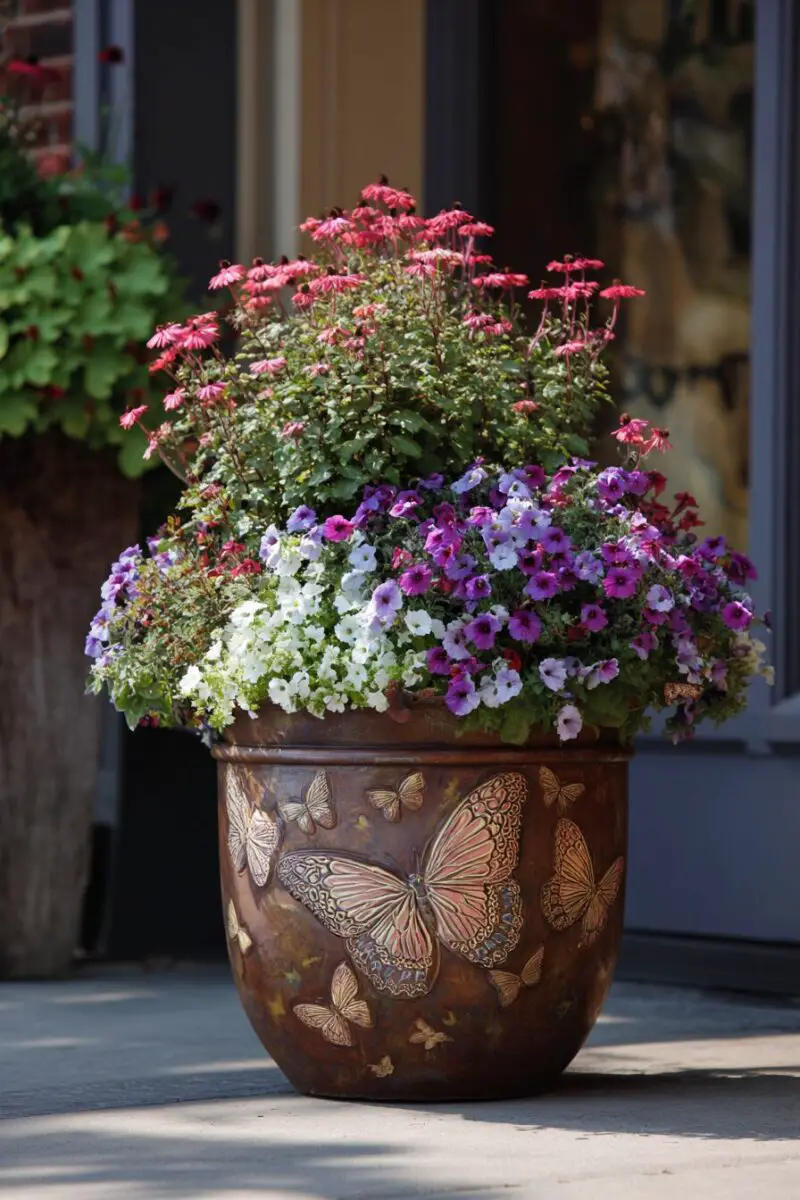
Transform your balcony or patio into a magical space where colorful butterflies dance from bloom to bloom, creating a living display more captivating than any decoration you could buy.
Creating a butterfly-specific container garden doesn’t just add beauty to your space—it helps support declining pollinator populations while giving you front-row seats to one of nature’s most fascinating shows.
The trick to attracting a diversity of butterflies is combining both nectar plants for the adults and host plants where they can lay eggs and feed their caterpillars.
Start with a large container at least 18 inches deep and wide, as butterfly-attracting plants tend to be on the larger side and need room to flourish.
Choose a centerpiece plant like butterfly bush (Buddleia) or coneflower (Echinacea) that produces abundant nectar and creates height in the center of your arrangement.
Surround your focal plant with medium-height bloomers like lantana, salvia, or zinnias that provide different flower shapes and blooming periods to attract diverse butterfly species.
Include flowering herbs like anise hyssop or Mexican mint marigold that serve double-duty as both butterfly nectar sources and additions to your kitchen.
Edge your container with trailing verbena or sweet alyssum that will cascade over the sides while providing landing pads for smaller butterfly species.
Crucially, include at least one host plant like parsley, dill, or milkweed where butterflies can lay eggs—without these, you’ll attract visitors but not residents.
Position your butterfly container where you can easily observe it from a window or seating area, but also where it receives at least 6 hours of direct sunlight daily.
Avoid using any pesticides—even organic ones—as they can harm the very butterflies and caterpillars you’re trying to attract.
Water deeply but allow the soil to dry slightly between waterings, as many butterfly-attracting plants prefer moderate drought conditions that concentrate flower nectar.
Garden Tower Container
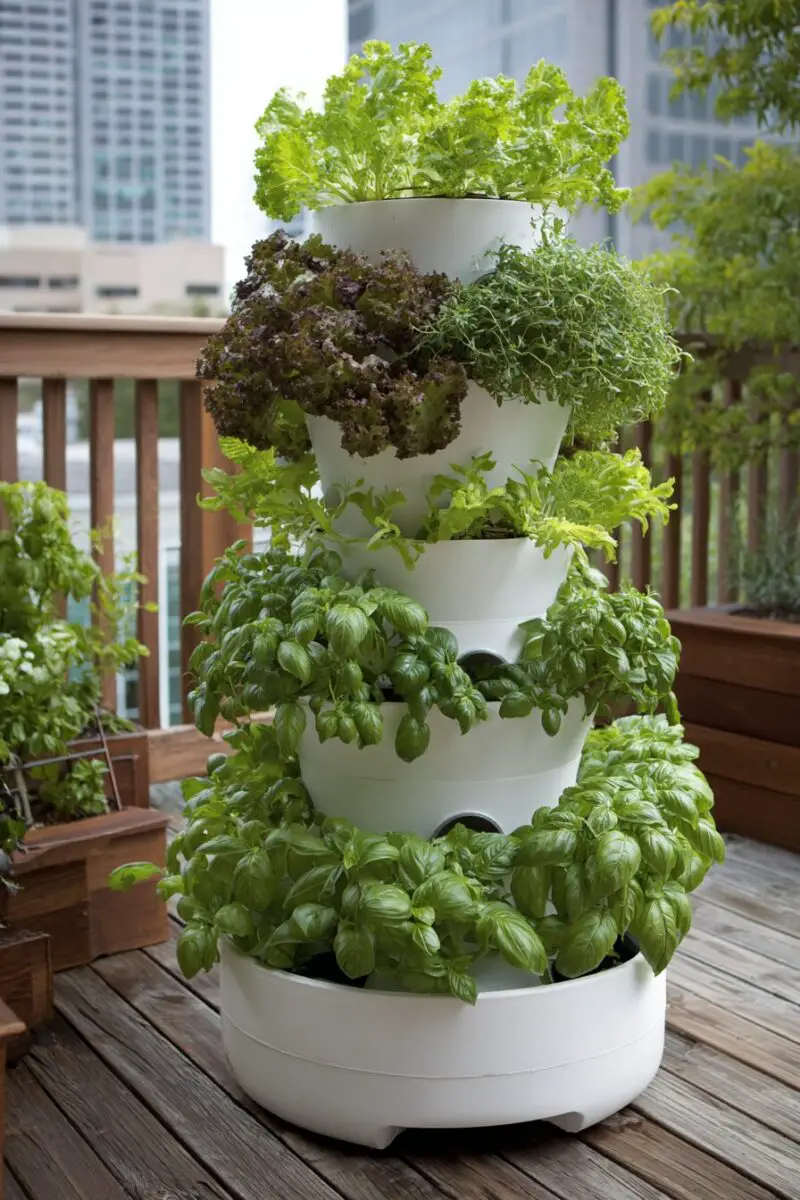
Imagine stepping onto your patio to harvest everything needed for restaurant-quality salsa fresca in less than 60 seconds.
A vertical salsa garden maximizes limited space while showcasing the striking foliage and fruit colors of these heat-loving crops.
This practical container idea combines beauty with genuine utility, giving you a constant supply of fresh ingredients that store-bought versions simply can’t match in flavor.
Start with a tiered planter, strawberry tower, or stack of decreasing-sized pots to create a space-efficient vertical growing system perfect for sunny balconies or small patios.
Plant determinate tomatoes like ‘Tiny Tim’ or ‘Patio Choice Yellow’ at the top level where they can cascade downward as they grow without shading other plants.
Position several varieties of hot peppers—from mild poblanos to fiery habaneros—in the middle sections where they’ll receive plenty of sun to develop their best heat and flavor.
Use the lower levels for cilantro, which can be succession-planted every few weeks to ensure a continuous harvest throughout the season.
Add green onions around the edges of multiple levels, where they’ll quickly regrow after cutting and add visual interest with their upright form.
Include garlic chives as both a decorative element and flavor addition, with their starry purple flowers attracting beneficial insects that help control pests.
For unexpected color and flavor dimension, add a trailing variety of strawberry that will produce sweet fruits to balance the heat in your fresh salsa creations.
Water consistently but allow the soil to dry slightly between waterings, as slightly water-stressed tomatoes and peppers actually develop more intense flavors.
Fertilize every two weeks with a bloom-boosting formula (higher in phosphorus) to encourage maximum fruit production from your tomatoes and peppers.
TRENDING NOW
Rock Landscaping Ideas For Your GardenCocktail Container

Container-grown dwarf citrus trees aren’t just productive—they’re stunning ornamental specimens that create an instant tropical vibe even in non-tropical climates.
The fragrance alone from citrus blossoms is intoxicating, filling your outdoor space with a sweet perfume that no candle or diffuser could ever truly replicate.
Start with a large, high-quality container at least 24 inches wide and deep, preferably made of durable material like fiberglass that resembles ceramic but weighs less and insulates roots better.
Choose dwarf varieties specifically bred for containers like ‘Improved Meyer’ lemon, ‘Bearss’ lime, or ‘Calamondin’ orange that will stay proportional to your space.
Use a specialized citrus potting mix that provides the perfect balance of drainage and moisture retention, or create your own by mixing regular potting soil with coco coir and extra perlite.
Plant your citrus tree slightly higher than it was in its nursery pot, with the root flare visible above the soil line to prevent deadly collar rot.
Underplant your citrus with complementary herbs used in cocktails, like mint, basil, or lemon verbena, which thrive in the same conditions and create a lush, full appearance.
Water thoroughly when the top two inches of soil feel dry, allowing water to flow through the drainage holes, but never let your citrus sit in standing water.
Feed regularly with a slow-release citrus fertilizer high in nitrogen, applying it more frequently during active growing seasons (spring and summer) and reducing in winter.
Position your container where it will receive maximum sunlight—at least 6-8 hours daily—as insufficient light is the primary reason container citrus fails to flower and fruit.
Bring your citrus container indoors when temperatures drop below 32°F, placing it near your brightest window or under grow lights until danger of frost has passed.
TRENDING NOW
13 Greenhouse-Shed Combos For Optimal GardeningCut Flower Power Container
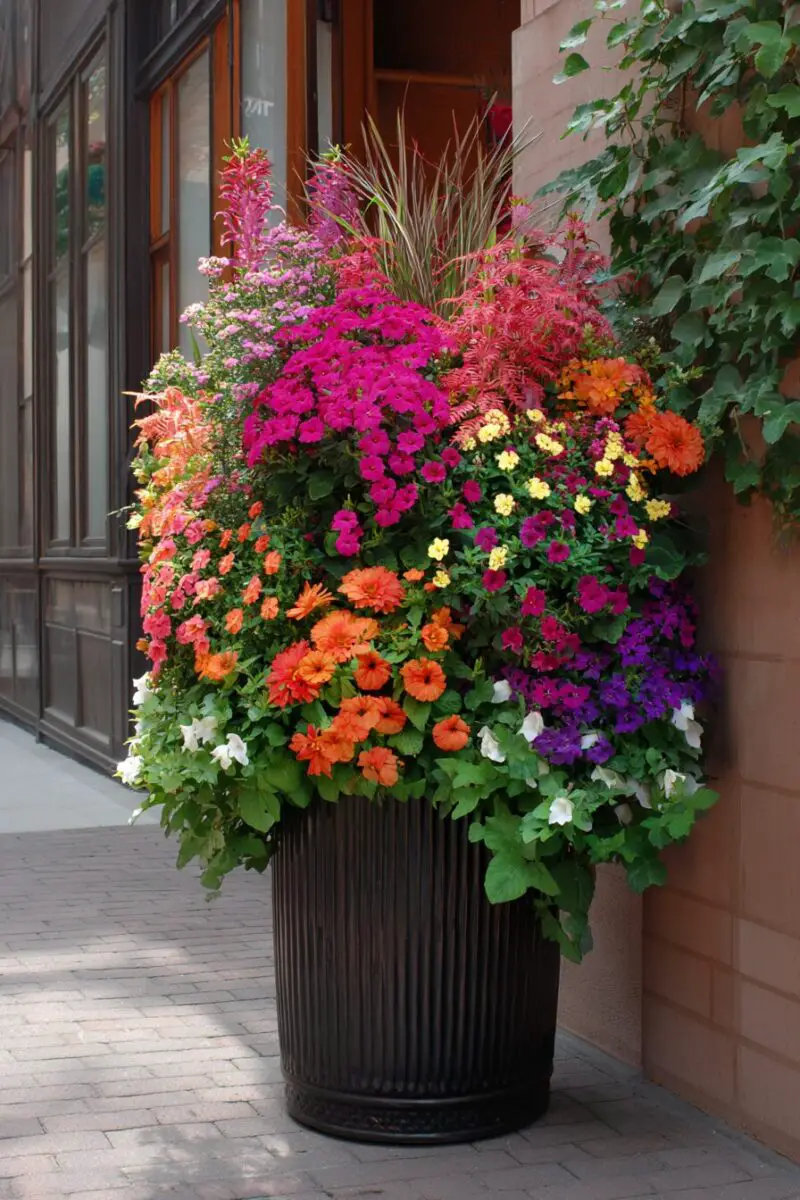
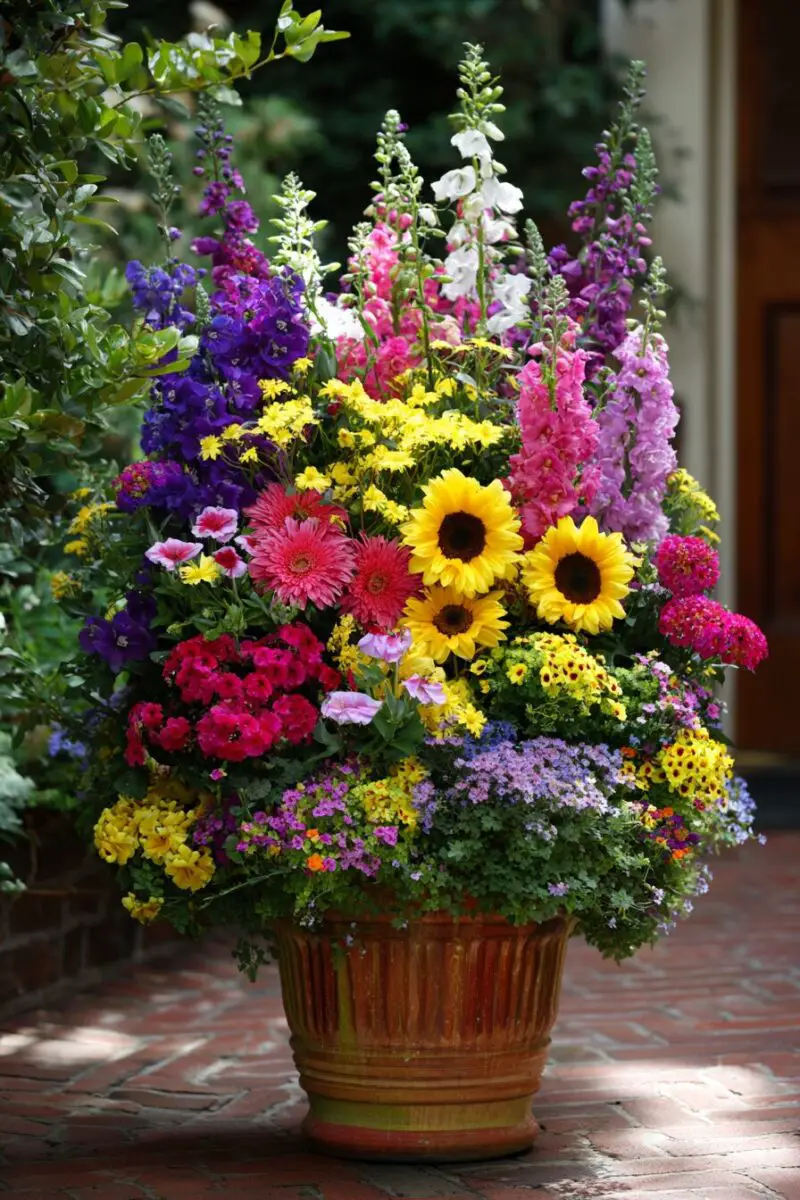
Imagine having a perpetual supply of designer-worthy bouquets just steps from your door, saving hundreds of dollars annually while enjoying flowers at their freshest peak.
A dedicated cutting garden container transforms your outdoor space into both a visual feast and a practical flower farm that keeps your home filled with seasonal blooms.
Unlike traditional ornamental containers where disturbing the display feels wasteful, a cutting garden is designed specifically for harvest—the more you cut, the more it produces.
Start with a generous container at least 18 inches deep and 24 inches wide, as crowded plants produce smaller, shorter-stemmed flowers unsuitable for arrangements.
Choose a color palette that complements your home’s interior where the cut flowers will eventually live—perhaps cool blues and purples or vibrant sunset tones of orange and pink.
Plant tall varieties like cosmos, zinnias, and sunflowers in the center where they won’t shade out other plants and their long stems can easily be harvested.
Surround these with medium-height flowers like rudbeckia, gaillardia, or salvias that provide different flower forms and textures for interesting arrangements.
Edge your container with flowering herbs like lavender or flowering tobacco (Nicotiana) that add fragrance to both the outdoor display and your indoor bouquets.
Include several filler plants like ammi (false Queen Anne’s lace) or bells of Ireland that add airy structure to both your container and the arrangements you’ll create.
Water deeply but allow the soil to dry slightly between waterings, as slightly stressed flowering plants often produce more abundant blooms on stronger stems.
Fertilize regularly with a bloom-boosting formula higher in phosphorus to encourage maximum flower production rather than leafy growth.
Harvest flowers in early morning when stems are filled with moisture and cut them at an angle with sharp scissors, immediately placing them in water to maximize vase life.
Berry Bonanza Container
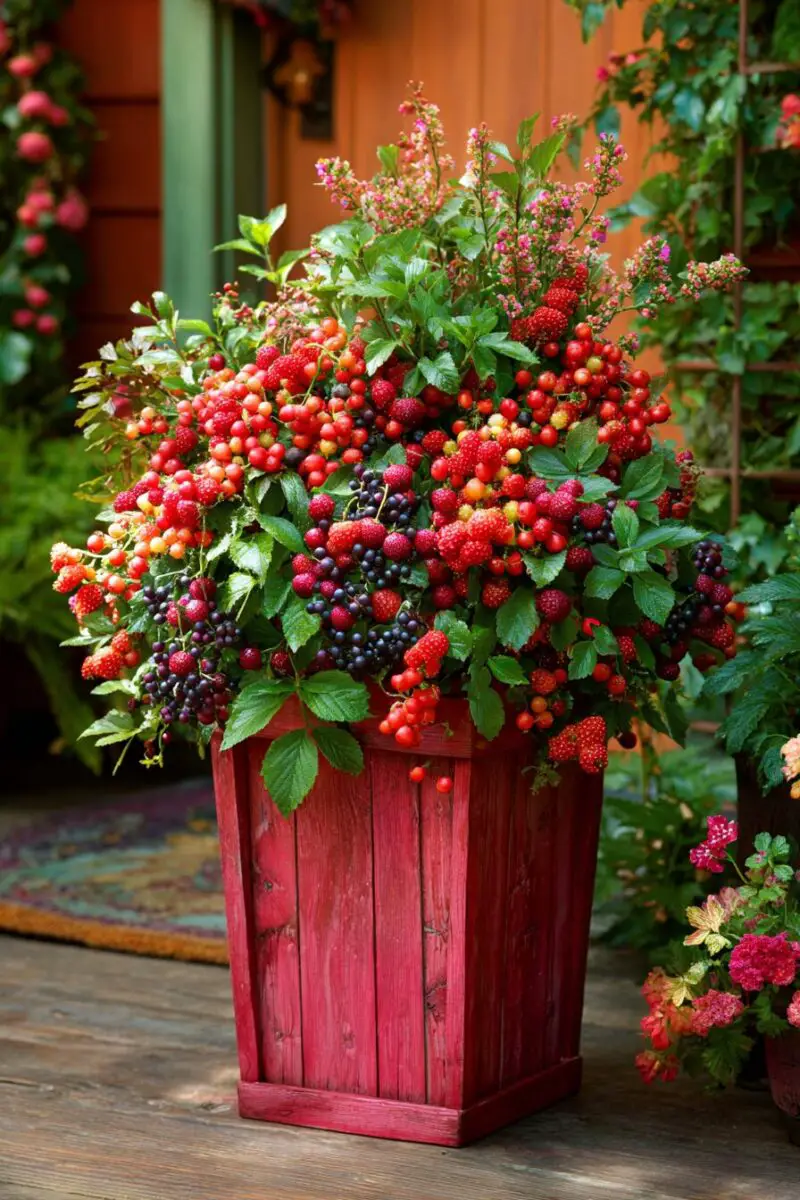
Imagine stepping onto your patio on a summer morning and picking sun-warmed berries for your breakfast cereal or smoothie—a luxury that even upscale grocery stores can’t match.
Container-grown berries deliver the impossible combination of ornamental beauty and mouth-watering harvests in a space no larger than a coffee table.
The compact growth habit of many modern berry varieties makes them perfect container specimens, with their seasonal progression from flowers to colorful fruits creating a constantly changing display.
Start with a large container at least 18-24 inches deep to accommodate the root systems and provide stability for top-heavy fruiting plants.
Choose everbearing varieties that produce multiple harvests throughout the season rather than one big crop, giving you months of enjoyment from a single planting.
For strawberries, consider specialized strawberry pots with multiple planting pockets or hanging baskets that allow the fruits to dangle attractively away from soil where they might rot.
Blueberries make spectacular container specimens with their spring flowers, summer berries, and often brilliant fall foliage—just be sure to select compact varieties like ‘Top Hat’ or ‘Peach Sorbet.’
Thornless blackberry varieties like ‘Baby Cakes’ offer the perfect combination of dramatic arching canes loaded with berries without the hazardous thorns of older varieties.
For raspberry lovers, look for dwarf varieties like ‘Raspberry Shortcake’ that stay naturally compact without the extensive pruning and trellising that full-sized varieties require.
Use a high-quality potting mix enriched with compost, and for acid-loving berries like blueberries, add peat moss or use a specialized soil designed for azaleas and rhododendrons.
Water consistently, keeping the soil evenly moist but not waterlogged, as fluctuating moisture levels can cause berries to crack or develop poorly.
Fertilize with a balanced organic fertilizer designed for fruiting plants, applying at half strength but more frequently than directed for in-ground plants.
Perennial Pollinator Tower

Imagine creating a living skyscraper of blooms that not only turns heads with its vertical drama but also becomes a bustling hub of beneficial insect activity.
A pollinator tower combines the space efficiency of vertical gardening with the ecological benefits of supporting native bees, butterflies, and other beneficial insects.
Unlike temporary annual displays, a perennial pollinator tower becomes more impressive each year as plants mature, creating a self-sustaining ecosystem that improves your other garden areas through increased pollination.
Start with a sturdy vertical structure like a commercial tower planter, stacked pots of decreasing sizes, or even a repurposed wooden pallet secured upright.
Choose sun-loving perennials with different blooming periods to provide continuous nectar sources from spring through fall, ensuring your tower remains colorful and ecologically valuable for months.
Include early-season bloomers like coreopsis and salvia at the top levels where they’ll receive maximum light and create a stunning cap of color.
Position mid-season powerhouses like echinacea and rudbeckia in the middle sections, where their sturdy stems and long-lasting blooms create reliable summer interest.
Use the lower levels for late-season performers like sedum and asters that will extend the tower’s ecological value into fall when many nectar sources have disappeared.
Incorporate native grasses like little bluestem or prairie dropseed in strategic positions to provide winter interest and critical habitat for pollinator eggs and larvae.
Choose compact varieties specifically bred for container culture, as many traditional perennials can become too large and unmanageable in confined spaces.
Water thoroughly but infrequently, allowing the soil to dry slightly between waterings, as most pollinator-friendly perennials prefer well-drained conditions similar to their native habitats.
Avoid deadheading spent blooms until late fall, as the seedheads provide valuable food sources for birds while adding architectural interest to your tower during winter months.
TRENDING NOW
13 Creative French Doors Patio Ideas For Every StyleFlower Cascade
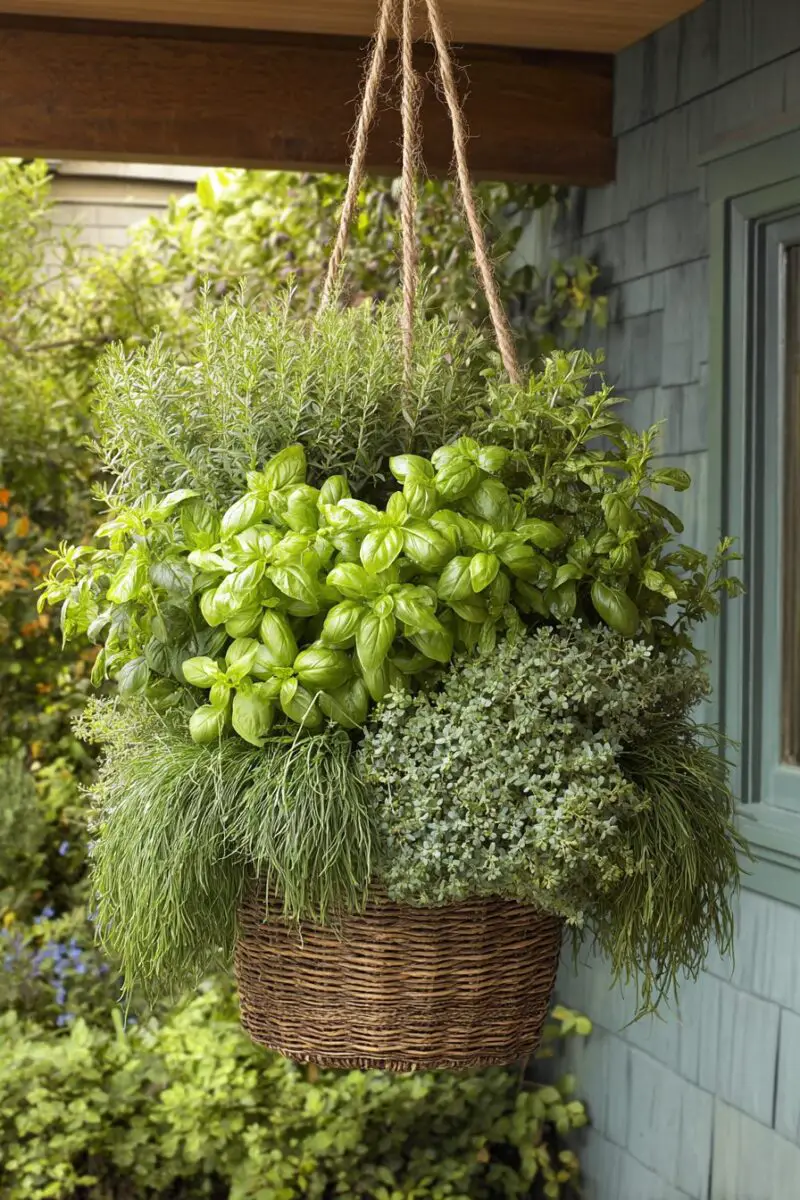
Imagine serving summer salads garnished with vibrantly colored, delicately flavored blossoms that make your guests’ eyes widen with delight—all grown in a single stunning container.
An edible flower container combines show-stopping ornamental appeal with culinary functionality, elevating your cooking from merely delicious to visually spectacular.
Unlike purely decorative containers, an edible flower display connects you to the centuries-old tradition of flower cuisine practiced across cultures from Mediterranean to Asian.
Start with a large hanging basket or cascading container where trailing plants can spill over the edges, creating a waterfall effect of colorful, edible blooms.
Choose nasturtiums as your anchor plant, with their lily pad-like leaves and peppery-flavored flowers in sunrise shades of red, orange, and yellow creating dramatic spillover.
Include calendula (pot marigold) for its sunny yellow and orange petals that add a saffron-like color and subtle flavor to rice dishes and salads.
Position compact varieties of pansies and violas near the container’s edges, where their charming “faces” can be easily viewed and their mild, sweet flavor harvested regularly.
Add scarlet runner beans that will climb any vertical support while producing both edible flowers and beans, creating height and structure in your arrangement.
Incorporate herb flowers like chive blossoms and borage, which add starry blue and purple accents while providing onion and cucumber flavors respectively.
Use johnny-jump-ups as fillers throughout the container, as these tough little flowers bloom prolifically, self-seed easily, and offer a wintergreen-like flavor.
Water consistently but allow the soil to dry slightly between waterings, as slightly stressed edible flowers often develop more concentrated flavors and colors.
Avoid all chemical pesticides and fertilizers, using only organic growing methods to ensure your edible flowers are safe for consumption.
The beauty of container gardening lies in its flexibility—you can mix and match these concepts or adapt them to your specific space and climate.
Remember that plants in full-sun containers typically need more frequent watering and occasional feeding to perform their best.
Your sun-drenched space is about to become your favorite part of home!

